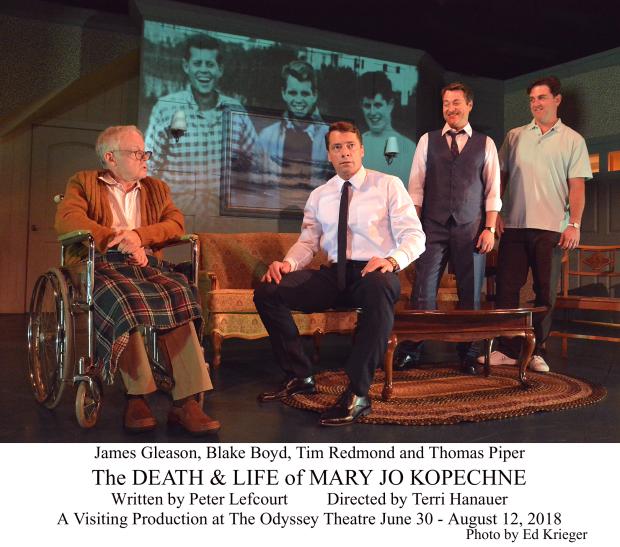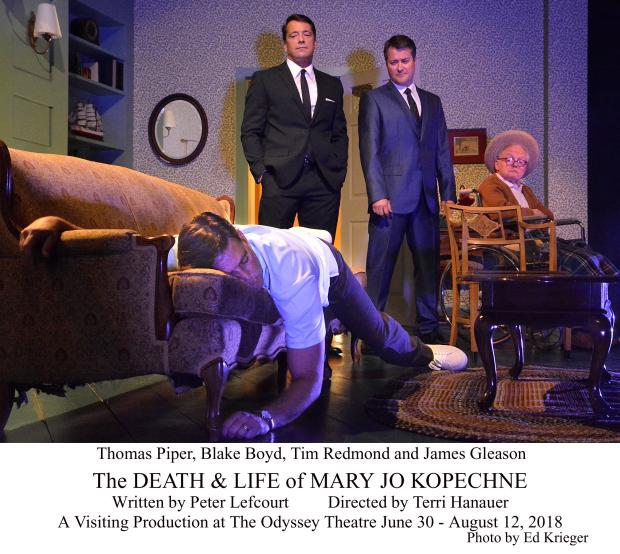Trivia Pursuit Question of the Review: What great film director tried to adapt Theodore Dreiser’s “An American Tragedy” in the early 1930s?
One of the best things that theater and film can do is take us long and ago and far away to experience actual historical events and figures. An excellent case in point is William Manus’ WWII-era set Their Finest Hour: Churchill and Murrow, which co-stars Michael Karm as the Prime Minister, Tyler Cook as the CBS broadcaster and Chantelle Albers as Pamela Churchill Harriman. This drama, which brings alive the Battle of Britain and real life personages, is on the boards in L.A. at the Brickhouse Theatre through July 22.
Although Peter Lefcourt’s The Death and Life of Mary Jo Kopechne likewise depicts notables who lived and a devastating happening, unlike Finest Hour this fanciful look at what may well be the Kennedys’ worst hours is not fact-based. Lefcourt’s revisiting of the incident at Chappaquiddick is creatively re-imagined here with little, if any, regard for or relationship to reality. The 1969 auto accident at Martha’s Vineyard involving Sen. Edward Kennedy (Thomas Piper) that left the titular Mary Jo Kopechne (Cathryn Dylan) dead and landed the presidential aspirant in lots of hot water did indeed occur. But much of Mary Jo is more like a Twilight Zone episode than a Ken Burns documentary.
This critic hates to divulge story details and ruin surprises for readers, but it is mission impossible to review this particular two-acter without disclosing some plot points. So let this advisory serve as a plot spoiler alert. In Lefcourt’s bizarre play Teddy’s two older - and assassinated - brothers, JFK (Blake Boyd) and Bobby (Tim Redmond), arrive from the grave, wheeling their wheeler-dealer, wheelchair-bound father, Joseph Kennedy (James Gleason portrays the patriarch who was still alive in 1969) in to save the day, and Teddy’s political prospects and future.
True to form, the cunning, conniving politicos strive to rescue the Kennedy clan’s fortunes in Washington by concocting and calculating how their little brother/son can explain away his failure to report the car wreck, rescue Mary Jo, alcohol use, a purported beach tryst with the younger single Democratic Party female campaign worker and so on. Details are murky - was there hanky-panky? - but Lefcourt doesn’t let the facts get in the way of telling (his side of) the story.
Along the way there’s lots of banter that ties into Kennedy lore and legends, such as reflections on the so-called “Kennedy curse,” their womanizing and so on. But as this is a ghost story, take one guess who ethereally appears to gum up the works for the manupulators?
There are some clever bits in Lefcourt’s kooky Kennedy concoction, which is directed by Terri Hanauer. For instance, some witty projections (designed by Katerina Pagsolingan) are shown and George Stevens’ screen adaptation of Theodore Dreiser’s novel An American Tragedy - 1951’s A Place in the Sun starring Montgomery Clift, Elizabeth Taylor and Shelley Winters - plays on a TV set that Teddy can’t shut off. Of course, this is a movie about class status and the drowning of a young woman. (However, the onstage television set has an illusion-shattering cable - years before cable TV appeared on the scene. I can willingly suspend my disbelief to believe in theatrical ghosts - but not that there was cable TV back in 1969.)
In Mary Jo Joseph ruminates about fascistic Sen. Joe McCarthy and his connections to the witch-hunter, but for some reason RFK’s working as a staffer on Tailgunner Joe’s Senate Permanent Subcommittee sniffing out commies during the Red Scare goes unmentioned.
There is also a meditation upon the #MeToo Movement’s issues. Although Mary Jo doesn’t accuse Ted of outright rape she does question the appropriateness of a married man of power and position having an alleged tryst with a younger woman who is much lower on the social status totem pole. BTW, if the spirit of Mary Jo (who is depicted as not being completely “innocent” herself) and Teddy reach any sort of understanding and rapprochement, this point was not dramatized well and I had trouble grasping it, if that was meant to be the case.
It’s very hard to convincingly portray actual highly recognizable people. For example, l’ve seen a bio-play about Marilyn Monroe played by a flat-chested actress. (Of course, as Mary Jo is about the Kennedys, Marilyn and her alleged dalliances with Bobby and Jack are mentioned in Lefcourt’s play.) Unfortunately, neither Piper nor Redmond resemble or otherwise embody the Kennedy persona. They are decent actors but I was not convinced that they personified the slain brothers (however, their brotherly repartee and horseplay throughout is amusing).
Gleason does come across well as the control freak, scheming former ambassador and Boyd (who previously played Bobby in Marilyn - My Secret and whose parents, according to the playbill, tried to see JFK in Dallas the day he was whacked) is especially good as Jack. He plays JFK with a devil-may-care, roguish twinkle in his eye, kind of looks the part, and is probably the best at capturing the essence and persona of the real life person being portrayed. (However, I must candidly confess I have little if any idea what Kopechne was really like.)
Your response to this play will likely be determined by how you feel about the characters. The depictions of Trotsky, Diego Rivera and Frida Kahlo in Lefcourt’s similarly styled The Assassination of Leon Trotsky: A Comedy was genuinely despicable and odious to admirers of the Russian revolutionary and/or Mexican daubers. (The title of the play, which I also saw at the Odyssey Theatre, says it all - Lefcourt thinks smashing an icepick into somebody’s skull is a laughing matter.)
Similarly, if you’re a fan of any of the Kennedys you’ll probably immensely hate this drama which has some comic, whimsical touches (including trite music oft-used to signal fantasy scenes onscreen). Devotees of the Kennedys believe, among other things, that they rose above their Irish immigrant roots in a prejudiced nation to attain the American Dream, and then conscientiously dedicated their lives to public service. In particular, Bobby aficionados will find this world premiere opening shortly after the 50th anniversary of his shooting right here in L.A. to be especially distasteful and disrespectful. RFK enthusiasts believe that Bobby’s Appalachia tour, support for Chicano migrant laborers and ag workers, anti-war stance, etc., elevated him to sainthood and with his murder, martyrdom. But Redmond’s RFK is a ruthless schemer trying to get Teddy off the hook for any possible wrongdoing and preserve his chance for a future foray for the Oval Office. (No wonder Teddy was flustered during his 1980 primary challenge against Jimmy Carter when a reporter asked him why he thought he should be president.)
On the other hand, if you despise the Kennedys you’re likely to enjoy and revel in its portrayal of these Machiavellian Massachusetts co-conspirator clansmen and find this play to be quite witty. Whether Lefcourt, an Emmy-winning writer, is a shrewd observer or merely a wise guy bearing a loaded, acid-dipped pen probably depends on where you stand re: one of America’s most prominent political families. Of course, not everybody has strong feelings about the Hyannis Port dynasty and I wonder whether this play will sway neutral viewers one way or the other. Who knows? The answer is, shall we say, a shot in the dark.
Answer to the Review ‘sTrivia Pursuit Question: Ivor Montagu’s 1967 memoir “With Eisenstein in Hollywood” chronicles Sergei Eisenstein’s effort to shoot Theodore Dreiser’s “An American Tragedy” for Paramount during the Soviet director’s sojourn to La-La-Land circa 1930 and publishes the screenplay Eisenstein co-wrote with Montagu. Their class conscious rendition was not to be - Josef von Sternberg directed a version with Sylvia Sidney in 1931 and 20 years later George Stevens helmed the adaptation retitled “A Place in the Sun” glimpsed onstage during “Mary Jo”, which was co-written by blacklisted screenwriter Michael Wilson.
The Death and Life of Mary Jo Kopechne plays Fridays and Saturdays at 8:00 p.m., and Sundays at 2:00 p.m. through Aug. 12 at the Odyssey Theatre, 2055 S. Sepulveda Blvd., Los Angeles, CA. For more info: (323)960-4418; www.Plays411.com/MaryJo.
The third edition of “The Hawaii Movie and Television Book” co-authored by L.A.-based reviewer/historian Ed Rampell is now available at: https://mutualpublishing.com/product/the-hawaii-movie-and-television-book/ .



